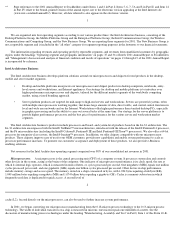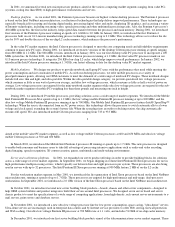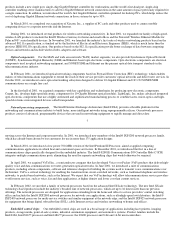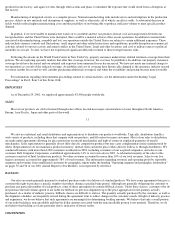Intel 2001 Annual Report Download - page 13
Download and view the complete annual report
Please find page 13 of the 2001 Intel annual report below. You can navigate through the pages in the report by either clicking on the pages listed below, or by using the keyword search tool below to find specific information within the annual report.
baseband chipset market segments.
RESEARCH AND DEVELOPMENT
We have maintained our competitive position to a large extent because of our emphasis on research and development. This emphasis has
enabled us to deliver leading-edge technology and has permitted our customers to commit to the use of these new products in the development
of their own products. Our research and development activities are directed toward developing new products; hardware technologies;
manufacturing, packaging and testing processes, as well as improving existing products and lowering costs.
We perform a substantial majority of the design and development of components and other products in the United States at our facilities in
California, Oregon, Arizona and Washington. Outside the United States, we have product development facilities at various locations, including
Israel, Malaysia, India, China and Russia. We also maintain research and development facilities in California and Oregon that are focused on
improving manufacturing processes, as well as a facility in Arizona that is dedicated to improvements in manufacturing, assembly and test
processes.
During the second quarter of 2001, our customers began shipping servers and workstations based on the Intel Itanium processor, the first
in the family of our 64-bit Itanium architecture products. The introduction of the Itanium processor is an important technology landmark for
both the end user and IT supplier community.
During the third quarter of 2001, we announced two technology breakthroughs, including the TeraHertz transistor and Hyper-Threading
technology. Based on new structures and materials, a TeraHertz transistor is designed to overcome a number of the technical barriers to
continued industry progress according to what is referred to as "Moore's Law". Moore's Law has accurately predicted that the number of
transistors that can be placed on a computer chip will double approximately every couple of years. When used in future technology generations,
TeraHertz transistors are expected to enable chips with 25 times the number of transistors of today's microprocessors, operating at 10 times the
speed, with no increase in power consumption or heat dissipation.
Hyper-Threading technology is a new processor design that we expect will significantly improve system performance for servers. Our
simultaneous multi-threading design allows a single processor to manage data as if it were two processors by handling data instructions in
parallel rather than one at a time. Using Hyper-Threading technology, data instructions are "threaded" as parallel streams for processing.
In September 2001, we announced the creation of new organization called the Corporate Technology Group (CTG), which will provide
research and technology direction across product lines, and will work with the industry to create and deliver key industry specifications,
standards and technologies. As part of the creation of CTG, we also announced the appointment a Chief Technology Officer.
In addition to microprocessor and chipset research and development, we have research and development initiatives in networking and
communications products, wireless devices, connected peripherals and other areas. These research and development initiatives include projects
surrounding the Intel IXA architecture for networking and communications products and the Intel PCA architecture for wireless devices. We
have also acquired ongoing research and development activities in these areas with businesses acquired in 2001.
Our expenditures for research and development were $3,796 million in fiscal 2001, $3,897 million in fiscal 2000 and $3,111 million in
fiscal 1999. These amounts exclude charges for purchased in-process research and development related to acquisitions of $198 million for
fiscal 2001, $109 million for fiscal
14
2000 and $392 million for fiscal 1999. The decline in spending between 2001 and 2000 reflects the impact of cost containment programs
including reductions in discretionary spending on travel-related expenses.
At December 2001, we had approximately 21,000 employees engaged in research and development. The success of our research and
development activities is dependent upon competitive circumstances as well as our ability to bring new products to market in each computing
market segment and in our other businesses in a timely and cost-effective manner.
ACQUISITIONS AND STRATEGIC INVESTMENTS
During 2001, we acquired 11 businesses for more than $1.7 billion, augmenting our capabilities in a number of strategic areas. The
companies acquired included Xircom, VxTel, LightLogic and Cognet, which are discussed under the "Products" heading in Part I, Item 1 of
this Form 10-K in connection with the Intel Communications Group.
Under our Intel Capital program, we also make equity investments to further our strategic objectives and to support our key business
initiatives for the desktop and mobile platforms, server platforms, networking and communications, and Internet services. We want to stimulate
growth in computing, communications and the Internet, and to grow the total information infrastructure, in order to create and expand markets
























